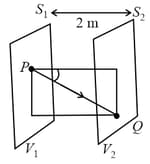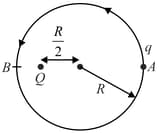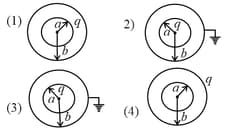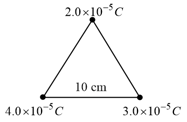Potential Energy of a System of Charges
Potential Energy of a System of Charges: Overview
This Topic covers sub-topics such as Electrostatic Potential Energy, Electrostatic Potential Energy of System of Point Charges and, Electrostatic Potential Energy between Two Point Charges
Important Questions on Potential Energy of a System of Charges
The term ‘potential energy’ of charge ‘q’ at a distance ‘r’ in an external electric field can be defined as:.
Two point charges C and C are separated by a distance of 50 cm in air.
(i) Find the point on the line joining the charges, where the electric potential is zero.
(ii) Also find the electrostatic potential energy of the system.
Charge , and are placed on a straight line as shown in figure. If the total potential energy of the system is zero then value of will be

Two fixed charges and of each are separated by a distance . is the midpoint of the line joining and . A charge of strength is shot perpendicular to the line joining and through with a kinetic energy of . The charge comes to rest at a point . The distance is
An electron is released from a distance of from a stationary point charge . What will be the speed of the electron when it is away from the point charge?
[Charge of electron , mass of electron , S.I. unit]
Two positive point charges of and are placed apart in air. The work done to bring them closer is
A disk of radius with uniform positive charge density is placed on the plane with its center at the origin. The Coulomb potential along the -axis is
A particle of positive charge is placed initially at rest at a point on the -axis with and . In addition to the Coulomb force, the particle experiences a vertical force with . Let . Which of the following statement(s) is(are) correct?
The energy required to move a charge of between two points is . The potential difference between them is
A tin nucleus has a charge of where is equal to . If a proton is at a distance of from a tin nucleus, then its potential energy is about
Two different equipotential surfaces $S_{1}$ and $S_{2}$ at electric potential $V_{1}$ and $V_{2}$ respectively are as shown in figure. The work done in moving a charge $q$ from $P$ to $Q$ is

There is a point charge at a distance from the centre of a circle of radius . Another point charge is to be moved from to , where and are two points on the circle diametrically opposite to each other. How much work is done by the electrostatic force exerted by on ?

Four identical charge particles having charge are placed fixed at the vertices of a square of side length . A negative charge having mass is situated at the centre of the square. The minimum velocity given to so that it can escape from there is,
In which of the following stores maximum energy?

Four point charges and are placed at the four vertices of a regular tetrahedron of side , while a charge is placed at its center. What is the total electrostatic energy of the system? (Vacuum permittivity is denoted by ).
Two equal points charges are fixed at & on -axis. Another point charge is placed at the origin. The change in electrical potential energy of , when it is displaced by a small amount or along -axis, is approximately proportional to.
How much work has to be done in assembling three charged particles at the vertices of an equilateral triangle as shown in figure?

A metallic sphere has a charge of . A unit negative charge is brought from to , both away from the sphere but being east of it while being on west. The net work done on the unit negative charge is
The velocity acquired by an electron starting from rest and moving through a potential difference is shown by the graph.
Three charges and are placed at the vertices and respectively of an isosceles right angled triangle , angle being and . If and then energy required to dissociate the system of charges is , then the value of rounded off to closest integer is -
Three charges, and , are placed at equal distances, on a straight line. If the potential energy of the system of three charges is zero, then what is the ratio of ?
